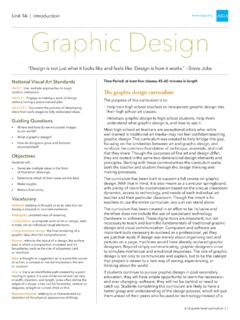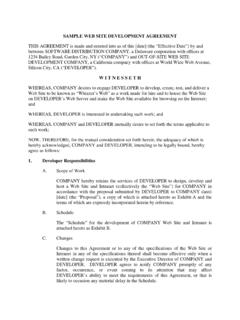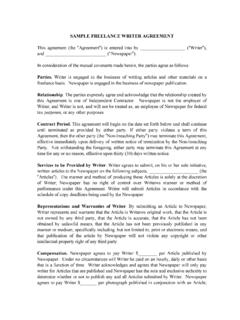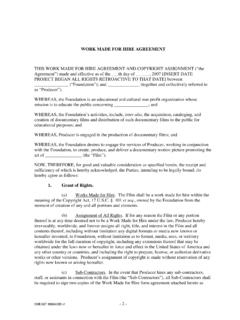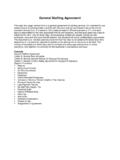Transcription of STANDARD FORM - AIGA
1 12 STANDARD form OF agreement FOR DESIGN SERVICESE very design project is different and the best will result from trust between the client and the designer. The most effective way to assure trust meets both client and designer expectations in an engagement is to codify the relationship with a written agreement . The STANDARD agreement is adaptable to unique circumstances while still drawing from the best proven practices based on mutual respect and clarity. It is a modular approach that recognizes the different needs and requirements of different types of form of Agreementfor Design ServicesIntroduction: AIGA STANDARD form of agreement 6 Basic Terms and Conditions 38 Schedule A: Intellectual Property Options 1.
2 License for Limited Usage 50 2. Exclusive License 54 3. Assignment of Rights 58 4. work Made for hire 60 Supplement 1: Print-Specific Terms and Conditions 64 Supplement 2: Interactive-Specific Terms and Conditions 66 Supplement 3: Environmental-Specific Terms and Conditions 68 Supplement 4: Motion-Specific Terms and Conditions 7256We l c o m e t o t h e l a t e s t v e r s i o n of t h e AIGA STANDARD form of agreement for Design Services. Just as in the prior update, it does not take a one-size-fits-all approach, and it is not an extensive pre-printed document where you simply fill in the blanks.
3 Instead, it acknowledges that most design firms develop their own custom proposal document for each project and are looking for an appropriate set of terms and conditions to attach to it. When put together and signed, the custom proposal document and its attached terms and conditions comprise the binding agreement with the this in mind, the focus of the AIGA STANDARD form of agreement is on those terms and conditions. AIGA members are involved in many different design disciplines. Because of this, the recommended terms and conditions have been prepared in a modular format. This also helps to keep individual agreements down to a more manageable size.
4 The first two modules, Basic Terms and Conditions and Intellectual Property Provisions, should be used for all design assignments. An additional four modules are provided as supplements that can be added to the agreement as needed: Print-Specific Ter ms and Conditions, Interactive-Specific Ter ms and Conditions, Environmental-Specific Terms and Conditions, and Motion-Specific Terms and : AIGA STANDARD form of AgreementProposal contents:Overview, Objectives, Process, Milestones,Fees, Expenses, work schedule, Billing schedule, Signature linesCover letterSupplemental terms for specific disciplines as neededBasic Terms and Conditions plus Intellectual Property Provisions (one of four options)Prepare in your own style & formatThen add the appropriate text modules from AIGA7 This update to the AIGA STANDARD form of agreement for Design Services was prepared by Linda Joy Kattwinkel (intellectual property attorney, Owen, Wickersham & Erickson)
5 And Shel Perkins (design management consultant, former AIGA national treasurer and past president of AIGA San Francisco). It builds on the prior version which they developed in collaboration with additional industry experts: Don Brunsten (intellectual property attorney, Don Brunsten & Associates), Jim Faris (co-founder of The Management Innovation Group and former AIGA national board member), and Frank Martinez (intellectual property attorney, The Martinez Group). It is being provided as a reference to all AIGA members. However, this information is not a substitute for personalized professional advice from an attorney.
6 If you have specific legal questions, you should always seek the services of appropriate legal to use itIn general, the process of drafting, negotiating and finalizing an agreement with a client will follow this sequence of activities:! Advance preparation and information gathering about the client and the potential project! Internal planning of budget and schedule! Drafting a custom proposal document that the client will see! Attaching these AIGA modules for all design projects: Basic Terms and Conditions and Schedule A: Intellectual Property Provisions (choose just one of the four available options)!
7 Adding these AIGA supplements as needed: Print-Specific Terms and Conditions, Interactive-Specific Terms and Conditions, Environmental-Specific Terms and Conditions, Motion-Specific Terms and Conditions! Reviewing the final AIGA checklist of options in the terms and conditions! Presenting the agreement to the client and answering any questions! Negotiating any modifications requested by the client! Finalizing the agreement with authorized signaturesThe following pages offer practical advice on the overall process and discuss the important legal and financial issues to be addressed in the fine print of any agreement .
8 To help you with the jargon involved, basic explanations of legal terms are included. However, these notes can only serve as a brief introduction to the issues involved. Depending on the type of work that you do and the size of your projects, some of the contractual issues can become rather complex. When finalizing an agreement with a client, you will of course want to have it reviewed by your attorney. 8 With that in mind, these notes end with some pointers on how to find the right attorney and make the best use of his or her time and preparation and project planning A proposal is a detailed project document that defines the scope of work , the process, the schedule, and the total price (usually in the form of a fixed fee).
9 It is a discussion document where the designer puts forward a recommended course of action for the client to consider. Many proposals go through several rounds of changes and negotiations before they are finalized. Some negotiations with the client may relate to project specifications while other discussions might focus on the legal terms and conditions. The final goal is to have one comprehensive document that, when accompanied by an appropriate set of terms and conditions and signed by both parties, serves as your agreement for the STEPS FOR YOUS tart with some general preparation that is relevant to all of the work done by your firm:!
10 Think about your creative process. Write down the ideal sequence of activities phases, steps and milestones that allows you to produce your best work . If you are active in more than one practice area, you may have several variations. Your own creative process should be the framework that you use for planning and managing projects.! Calculate a STANDARD hourly rate. This is an important internal tool that you need in order to sketch out initial budgets. Rates vary from firm to firm based on the amount of overhead being carried, the number of hours available to devote to client projects and the target profit margin included in the calculation.

